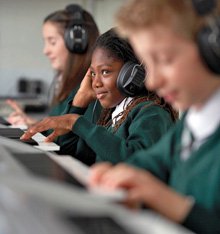Schools Embrace the Diversity of Student Skills
Schools around the country invest in the diversity of ability. Here’s a look at how some tap into a wide variety of student smarts.
Your content has been saved!
Go to My Saved Content.
This article accompanies the feature "An Educator's Journey Toward Multiple Intelligences."
These schools are putting multiple-intelligences theory into practice:
This K-5 magnet school in Jacksonville, Florida, uses what staffers refer to as the "eight kinds of smart" in all its practices. In fact, says magnet lead teacher Judy Bullard, "multiple intelligences is our theme, and parents choose our school because of that." Teachers' lesson plans highlight all eight intelligences and incorporate them into daily instruction as often as possible, and kids often get to choose how they'll pursue and present information.
For a history project, students strong in logical-mathematical ability might create time-sequence charts. Students who prefer visual or spatial learning can paint a mural about a historical period; kids who prefer physical activities might reenact great scenes from history, while learners who like music can make an instrument and then compose a piece for it. The school surveys to find out how individual kids learn best, and teachers work to improve the stronger intelligences and help students gain strength in other areas.
Country Springs Elementary School, Edwin Rhodes Elementary School
These schools in the Chino Valley Unified School District, in Chino, California, formally assess students at the beginning of the year using a variety of methods, including the Teele Inventory of Multiple Intelligences (TIMI).
At Country Springs, teachers design lesson plans around individual student interests. Whatever the topic -- English, history, math -- teachers allow for different types of learning by giving students choices. A book report? Kids might present a poem or write a skit (which classmates perform), create a rap or song, or choose to present material via picture or graph. Sixth graders learn geography, for example, by singing about the "seven silly continents," and learn history by creating timelines of their own lives -- with some kids creating scrapbooks and others making videos.
Edwin Rhodes teachers screen each child at the beginning of the year to reveal his or her two dominant intelligences. "Results are shared with parents," says school principal Sue Roche, "so if we know a child is especially bodily-kinesthetic, we give parents and kids tips on ways to learn and study for tests." Fifth-grade teacher Nancy Taylor knows her class is filled with bodily-kinesthetic and musical learners; she infuses lessons on density and volume with activities for different intelligences by asking, for instance, "How do we act out density?" and encourages kids to make up jingles about evaporation or condensation. "Teachers can get bogged down with paper and pencils, so they're not harnessing all the intelligences," says Roche. "They'll think they don't have time for other kinds of lessons. My philosophy is, you don't have time not to do those things."
Staffers at this Charlotte, North Carolina, school are concerned not with "How smart are you?" but, rather, with "How are you smart?" The K-5 school (recognized as a North Carolina School of Distinction last year) has a multiple-intelligences coordinator, who trains new staff members in MI theory.
This year, kids have presented major productions showcasing their lessons through singing, dancing, and playwriting. Third graders performed "It's All Greek to Me," translating lessons from science (the solar system), social studies (geography of Greece), and language arts (Greek mythology) to the stage. For five weeks, second graders studied spiders; classroom activities ranged from the bodily-kinesthetic (web spinning) to the verbal-linguistic (reading Charlotte's Web and writing poetry) to research projects (incorporating verbal-linguistic, visual-spatial, and interpersonal intelligences). Teachers helped students select a spider of interest, guiding them through their research, and students worked independently, in pairs, or in small groups to pull together facts about their featured spider and create a spider model.
In fifth grade, students studied colonial American history and the American Revolution, weaving in literary connections by reading The Midnight Ride of Paul Revere, Ben and Me, and My Brother Sam Is Dead. To demonstrate their understanding, each student researches and "becomes" a historical character by writing a speech and standing costumed in a colonial wax museum, where visitors touch the character and bring it to life.
This St. Louis elementary school fosters a full range of students' intelligences. "Our students cultivate a sense of self and their place in the world," explains the school's mission statement. "This gives them the ability to explore and learn and resist the temptation to define themselves through others." The first page of each New City report card is dedicated to students' development of the personal intelligences. Students are assessed on intrapersonal skills such as confidence, motivation, problem solving, and responsibility, as well as on interpersonal skills, including appreciation for diversity and teamwork.
Curriculum at this private school for grades 4-12 in Fairfax, Virginia, emphasizes the use of collaborative skills. Kids are encouraged to interact directly with their teachers, coming up with ideas together and approaching instructors as senior partners, explains Headmaster John Potter. Educators at the school link across disciplines to incorporate multiple intelligences into classwork. For instance, a science teacher might get kids to use their bodily-kinesthetic abilities by having them perform a lesson, representing a virus or the nucleus of a cell. At school meetings, multiple-intelligences discussions are a key part of staff development. The New School also has identified 12 essential skills that fit into its multiple-intelligences curriculum, such as teaching kids to communicate effectively, work collaboratively and creatively, and appreciate and understand different perspectives.